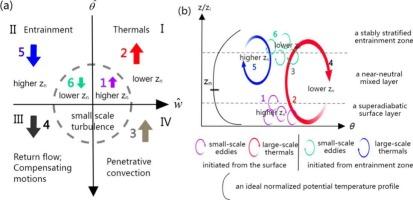IF 4.4
2区 地球科学
Q1 METEOROLOGY & ATMOSPHERIC SCIENCES
引用次数: 0
摘要
当涉及到再现对流边界层(CBL)的详细热力学结构时,结合不同行星边界层(PBL)方案的数值模式仍然存在很大的不确定性,特别是对于中性稳定性(zn)水平,在此水平上,静态不稳定的下层CBL开始过渡到稍微稳定的上层CBL。结果表明:高原zn的空间分布范围在0.16 ~ 0.38zi之间,以zi代表CBL深度,且zn在西南地区较高,在东南地区较低;地表- /夹带引起的大尺度热气流(对应于非局部通量)倾向于抑制/提升zn,这是由于暖空气渗透到CBL的上/下,而小尺度涡旋(对应于局部通量)对zn的作用正好相反。LES结果表明,在当地时间08:00(日出后约80 min)之前,由于地表诱导的小涡流在CBL发育早期占主导地位,zn增加。在此之后,随着大规模表面诱导的热变得更加活跃,zn下降。这一改进的认识为PBL方案的进一步改进提供了指导。然而,详细的CBL结构和高原上的影响因素尚未得到充分的研究。结合多年探空仪的位温(θ)精细分辨率剖面和大涡模拟(LES),我们研究了CBL的结构,特别是中性点(zn)的位置,这是一个将静态不稳定的下层CBL与稍微静态稳定的上层CBL分开的过渡水平。我们还研究了表面加热和夹带过程对CBL详细结构的影响。θ剖面呈三层结构,锌在高原上呈空间变化。不同大小的涡旋起源于地表和CBL顶部的夹带,对CBL的演化和zn的高度有协同作用。这种对CBL详细结构和相关物理过程的进一步了解,为利用PBL方案评估和校准数值天气预报模式提供了一个新的角度。本文章由计算机程序翻译,如有差异,请以英文原文为准。

Impact of surface and entrainment heat fluxes on the thermodynamic structure of the convective boundary layer over the Tibetan Plateau: Observations and modeling analysis
Substantial uncertainties remain in numerical models incorporating different planetary boundary layer (PBL) schemes when it comes to reproducing the detailed thermodynamic structure of the convective boundary layer (CBL), particularly for the level of neutral stability (zn), at which statically unstable lower CBL begins to transit into slightly stable upper CBL. Using multi-year radiosonde data from 12 stations and large-eddy simulation (LES), we examined the detailed CBL thermodynamic structure and processes over the Tibetan Plateau, particularly focusing on the impact of surface heating and entrainment on zn. The results indicated that the values of zn spatially ranged within 0.16–0.38zi on the plateau, with zi representing the CBL depth, and zn was higher in the southwestern region and lower in the southeastern region. Surface−/entrainment-induced large-scale thermals (corresponding to nonlocal fluxes) tended to suppress/elevate zn, due to warm air penetrating into the upper/lower CBL, whereas small-scale eddies (corresponding to local fluxes) exert the opposite effect on zn. The LES results indicated that zn increased before 08:00 Local Time (about 80 min after sunrise), as surface-induced small eddies dominated during the early stage of CBL development. After this time, zn decreased as large-scale surface-induced thermals became more active. This improved understanding provides guidance for further improvement of PBL schemes.
Plain language summary
Convective boundary layer (CBL) over the Tibetan Plateau plays an important role in the climate system in East Asia. Nevertheless, detailed CBL structure and the impact factors over the plateau have not been fully examined yet. Combining the multi-year radiosonde fine-resolution profiles of potential temperature (θ) with the large eddy simulation (LES), we investigate the CBL structure, particularly the position of neutral point (zn), a transition level separating the statically unstable lower CBL from the slightly statically stable upper CBL. We also examine the impacts of surface heating and entrainment process on detailed CBL structure. θ profiles exhibit a three-layer structure, with zn spatially varying over the plateau. Different eddies with different sizes initiated from the surface and from the entrainment zone at the CBL top synergistically affect the evolution of the CBL and the altitude of zn. This improved understanding of the detail CBL structure and the relevant physical processes provides a new angle to evaluate and calibrate numerical weather prediction (NWP) models with PBL schemes.
求助全文
通过发布文献求助,成功后即可免费获取论文全文。
去求助
来源期刊

Atmospheric Research
地学-气象与大气科学
CiteScore
9.40
自引率
10.90%
发文量
460
审稿时长
47 days
期刊介绍:
The journal publishes scientific papers (research papers, review articles, letters and notes) dealing with the part of the atmosphere where meteorological events occur. Attention is given to all processes extending from the earth surface to the tropopause, but special emphasis continues to be devoted to the physics of clouds, mesoscale meteorology and air pollution, i.e. atmospheric aerosols; microphysical processes; cloud dynamics and thermodynamics; numerical simulation, climatology, climate change and weather modification.
 求助内容:
求助内容: 应助结果提醒方式:
应助结果提醒方式:


